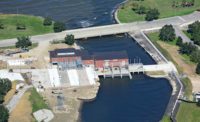A long-feared U.S. Gulf Coast disaster began to unfold Aug. 28 as raging Hurricane Katrina smashed ashore. Cities were inundated, streets looked like war zones and rescuers found clusters of bodies in homes and apartments where people riding out the storm lost their gamble. Katrina pushed contractors into action and left officials staring at the need for vastly stronger systems and policies for storm protection.
The picture was especially grim in once charming New Orleans, whose 130-mile wall of encircling levees was overtopped or breached in at least two places, sending rivers of water cascading into the streets. By the afternoon of Aug. 30, 80% of the city reportedly was under water. To the east, residents of Gulfport and Biloxi, Miss., also were stunned by deaths and catastrophic destruction. President Bush declared impacted parts of Louisiana, Mississippi, Florida and Alabama as major disaster areas.
A spokesman for natural disaster loss estimator EQECAT, Oakland, Calif., says until more information is available the company will stick by an estimate of insured commercial losses from Katrina of $9 billion to $16 billion that was issued before the levees began to go.
"That $16 billion includes a factor of unknown," says Tom Larsen, senior vice president. "I still think that is a credible bound for insured losses, but the total damage will be much higher. The government typically doesnt insure its own facilitiesthe levees and roads." That estimate also does not include residential losses covered by federal flood insurance. The biggest unknown is the business interruption loss, typically the largest component. That loss will depend mostly on how fast recovery operations move. It will have an unknown impact across the land because the offshore oil industry and port and rail operations were shut down.
At ENR press time, engineering and construction firms were mobilizing to join the U.S. Army Corps of Engineers and Federal Emergency Management Agency to mitigate the flooding and begin recovery efforts.
Corps personnel from New Orleans, Memphis and St. Louis convened Aug. 30 with hydraulics engineers at Vicksburg District headquarters. They conferred with state and local officials and contractors on the ground in New Orleans to try to staunch the flooding there and close a 200-ft-long breach in the 17th St. Canal. "Water was pouring in from broken levees," says Adam Wine, a U.S. Coast Guard spokesman, who flew over the city in a helicopter Monday. "There are some areas where the water was 25 ft deep."
"We think the water overtopped the floodwall and scoured out the foundation, leading to a structural failure," says Al Naomi, senior manager and head of the Corps Lake Pontchartrain and hurricane protection programs. The top of the concrete floodwall, which sits atop an earthen levee, was 14 or 15 ft above sea level at the point of failure, Naomi says. The city is 6 to 10 ft below sea level in that area.
The New Orleans Sewerage and Water Board operates a vast drainage system designed to collect water during storm events and pump it from the city into the canals and on to the lake. "Theres the biggest drainage pumping station in the world at the head of the canal," Naomi says. The system can pump 25,000 cu ft per second through three drainage canals over a seven-mile stretch, but "because of the breach, its shut down. So water is coming in from the lake to the city," Naomi says. "We have to devise a plan to plug the breach and turn the pumps back on." By midday Aug. 30, local accounts estimated that 80% of the city was flooded.
Downtown New Orleans was not submerged, but most of the eastern neighborhoods were inundated, says Wine. In many places, only overpasses break the surface. Elsewhere, he saw burning buildings, out of reach of fire department equipment. Nearby, the lakefront airport was totally submerged, a ship was aground and cargo containers were scattered randomly. "I could not believe the devastation," Wine says.
Corps engineers in Vicksburg were in contact with local officials and emergency contractors trying to devise a plan to plug the breach and reverse the flow. "There are about 30 super-sized sandbags, 3 ft x 3 ft each, near the site, with more available nearby," says Naomi. "Its very likely that the contractors will fill them and try to put them in place with heavy equipment to plug the hole. Then they would come in and drive sheet piles."
Repairs also are needed at a second breach, at the Inner Harbor Navigation Canal. Naomi says the floodwall was overtopped there as well. The storm...


Post a comment to this article
Report Abusive Comment